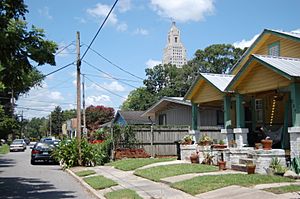Spanish Town, Baton Rouge, Louisiana facts for kids
Quick facts for kids |
|
|
Spanish Town
|
|
 |
|
| Location | Bounded by State Capitol Drive, North 5th Street, North 9th Street and North Street, Baton Rouge, Louisiana |
|---|---|
| Area | 49.4 acres (20.0 ha) |
| Built | 1862 |
| Architect | Potts, Nelson, et al. |
| Architectural style | Bungalow/American craftsman, Greek Revival, Late Victorian architecture |
| NRHP reference No. | 78001422 |
| Added to NRHP | August 31, 1978 |

Spanish Town (Spanish: Ciudad española) is a very old and special neighborhood in Baton Rouge. This city is the capital of the U.S. state of Louisiana. Spanish Town is famous for its yearly Mardi Gras parade. This parade is the biggest one in Baton Rouge!
Spanish Town was planned in 1805. It is the oldest neighborhood in Baton Rouge. Its area is about 49.4 acres (20.0 ha) (which is like 37 football fields). This area has 258 important buildings. It was added to the National Register of Historic Places on August 31, 1978. The buildings here were built between 1823 and 1975. The oldest house is the Pino House, built in 1823.
Contents
History of Spanish Town, Baton Rouge
How Spanish Town Started
The first plans for Spanish Town were made on December 11, 1804. A surveyor named Vicente S. Criado drew them. He planned for 14 families to live near Fort San Carlos. This was asked for by the governor of the area.
The neighborhood was officially started in 1805. This was done by a leader named Don Carlos de Grand Pré. People from the Canary Islands lived in a nearby town called Galvez Town. When Galvez Town became part of the United States in 1803, they wanted to keep living under Spanish rule.
So, in 1805, Carlos de Grand Pré helped them. He planned an area east of the fort. This new area became known as Spanish Town. It gave Spanish citizens a place for their culture and language.
Changes Over Time
Much of Spanish West Florida was part of New Spain after 1780. But many people living there were from England. They did not like being under Spanish rule. Baton Rouge was mostly an English-speaking area. Spanish Town gave Spanish people their own community.
The American Civil War caused a lot of damage. Only a few homes were left standing in Spanish Town. The area was mostly empty for a while. After the war, many African Americans moved there. Many were freed slaves looking for work in Baton Rouge. New homes and churches were built. The neighborhood became busy again.
Later, Louisiana State University was founded. This also changed the area. Between 1890 and 1920, Spanish Town grew. It became a place for students and teachers from the university to live.
Spanish Town Mardi Gras
Spanish Town is famous for Baton Rouge's biggest Mardi Gras parade. It happens every year on the Saturday before Mardi Gras. The first parade was in 1981. It was a way for people to celebrate their unique neighborhood.
The first parade was very small. A few children walked and played music. They threw small gifts to the crowd. Since then, it has grown a lot. Now it has big, fancy floats. The parade has a very funny and sometimes edgy style. It is generally not considered suitable for young children.
Each year, the parade has a different theme. The floats often make jokes about local and national leaders. They offer funny comments on current events. There are groups called Krewes, like in New Orleans Mardi Gras. But these Krewes are more relaxed. They have funny names like "Krewe of Roadkill."
The Pink Flamingo Mascot
The unofficial mascot of the parade is the pink flamingo. This bird has become a symbol for the whole Spanish Town neighborhood. The pink flamingo is said to represent the idea that "poor taste is better than no taste at all." This saying became popular as more unique people moved into the neighborhood.
There is a fun tradition in Baton Rouge involving pink flamingos. It started with the Spanish Town Mardi Gras. Around the start of Mardi Gras season, large pink flamingos are placed in the LSU Lakes. These lakes are next to LSU. The flamingos announce when the yearly Mardi Gras ball will happen.
It is a tradition to "kidnap" one of these flamingos. People usually take a boat out on the lake to get one. Then they use it to decorate their yard or home. People feel proud when they have one of these special flamingos.
Images for kids





